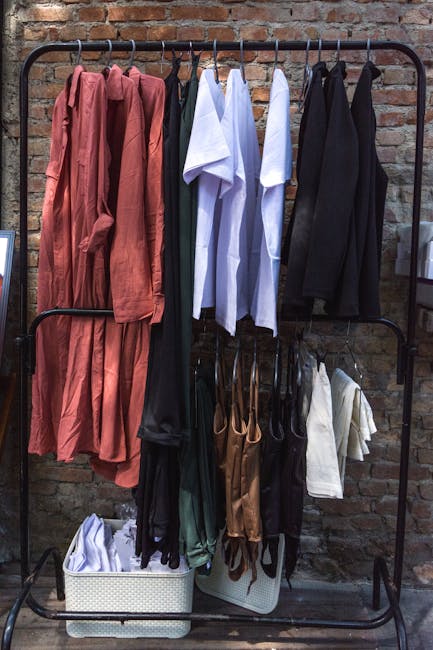
Good design isn’t just about aesthetics; it’s about crafting a visual identity that speaks volumes about a brand. Logo design, in particular, is an art form that requires finesse, creativity, and a keen eye for detail. However, it’s all too easy to fall into the trap of making common blunders that can derail even the most well-intentioned designer. So, grab your sketchpad and buckle up, because we’re about to navigate the treacherous waters of logo design and steer clear of some of the most laughable mistakes along the way. Let’s dive in!
Choosing the Right Font and Colors for Brand Identity
When it comes to choosing the right font and colors for your brand identity, it’s important to think beyond just your personal favorites. You wouldn’t wear a neon fanny pack to a black-tie event, would you? So, why should your brand be any different?
First off, let’s talk fonts – the unsung heroes of the design world. Think of fonts like your brand’s accent; they should add personality without overpowering the main message. Stay away from Comic Sans (duh) and opt for something sleek like Helvetica or Proxima Nova.
As for colors, think about the message you want to convey. Want to exude trustworthiness? Go for blues and greens. Looking to add a whimsical touch? Try purples and pinks. Just avoid colors that clash like your drunk uncle at Thanksgiving dinner. Stick to a cohesive color palette for a brand identity that’s as put-together as a Kardashian on a red carpet.
Remember, your font and colors are often the first impression people will have of your brand. So, don’t be a fashion faux pas – choose wisely and rock that brand identity like it’s your own personal runway.

Simplicity is key: Avoid Overly Complicated Designs
When it comes to design, less is definitely more. You don’t need all the bells and whistles to create a stunning masterpiece. In fact, simplicity is the key to catching someone’s eye and keeping them engaged. So, say goodbye to those overly complicated designs that make your head spin and embrace the beauty of minimalism.
Imagine a website with so many flashy elements that you don’t even know where to look first. It’s like being in a crowded room where everyone is trying to talk over each other – it’s chaotic and overwhelming. But when you strip away all the unnecessary clutter and focus on the essentials, suddenly everything starts to fall into place. Your design becomes sleek, elegant, and easy on the eyes.
So, why complicate things when you can keep it simple? With a clean and straightforward design, you can make a bold statement without saying a word. Your message becomes crystal clear, and your audience can effortlessly navigate through your site without getting lost in a sea of distractions. Remember, less is more, and sometimes, simplicity is all you need to make a lasting impression.
Next time you’re tempted to add one more widget or fancy animation to your design, take a step back and ask yourself if it’s really necessary. Embrace the power of simplicity and let your creativity shine through in the most subtle and elegant way possible. Trust me, your audience will thank you for it.

Adaptability Across Different Platforms and Sizes
Have you ever felt like a chameleon jumping from branch to branch, seamlessly blending in with your surroundings? Well, that’s exactly how works in the digital world! Like a well-choreographed dance routine, being able to adjust and shift based on the platform and size of your content is key to capturing your audience’s attention.
Picture this: you’re a tall, slender supermodel strutting down the runway in a gorgeous designer gown. Now imagine trying to squeeze into that same dress after a weekend of binge-eating pizza and ice cream. Yikes! The same concept applies to digital content – what looks good on a desktop may not translate well to a mobile device. That’s where adaptability comes into play, making sure your content looks just as fabulous no matter where it’s being viewed.
It’s like being a master of disguise, able to transform at a moment’s notice. Think of your content as a shape-shifter, able to morph and adjust to fit any situation. Whether your audience is scrolling through their social media feeds or perusing your website on a laptop, you want to make sure your content is always looking its best. So embrace your inner chameleon and get ready to conquer any platform or size that comes your way!

Creating a Timeless Design that Represents Your Brand
When it comes to creating a timeless design that truly represents your brand, there are a few key things to keep in mind. First and foremost, you want to make sure that your design is visually appealing and easy to recognize. This means using a cohesive color scheme, a memorable logo, and consistent branding elements throughout all of your materials.
Another important aspect of creating a timeless design is to think about your brand’s personality and values. Is your brand playful and fun, or is it more serious and professional? Make sure that your design reflects these traits in a way that will resonate with your target audience.
It’s also crucial to stay true to your brand’s roots while still being willing to evolve and adapt to changing trends. Remember, just because something is trendy now doesn’t mean it will stand the test of time. Instead, focus on creating a design that is classic and enduring, something that will still look great years from now.
So, whether you’re designing a new logo, updating your website, or creating a marketing campaign, remember to keep these tips in mind. By creating a timeless design that truly represents your brand, you can help solidify your place in the market and stand out from the competition. Happy designing!
Researching Competitors and Avoiding Similar Designs
So, you’ve got a brilliant idea for a new product, but before you hit the market with it, you need to do some competitive research. After all, you don’t want to launch something that’s already been done a million times before, right? Here are some tips to help you navigate the world of competitors and avoid falling into the trap of similar designs.
First things first, hop on your favorite search engine and start scouting out the competition. Take a look at what’s already out there and see if there are any products similar to yours. Pro-tip: Keep a list of your findings so you can reference them later on.
Next, dig a little deeper and examine the design elements of your competitors’ products. Are there any common themes or trends that you should be aware of? Make note of anything that stands out to you, whether it’s a particular color scheme, logo placement, or packaging style.
Once you’ve gathered all of your intel, it’s time to get creative and brainstorm ways to make your product stand out from the crowd. Think about what sets your idea apart and how you can capitalize on those unique attributes. Remember, the goal is to offer something fresh and exciting to consumers, so don’t be afraid to think outside the box!
Testing and Receiving Feedback for a Successful Logo Design
So, your logo design is finally ready! But before you start celebrating, it’s time to put it to the test and receive feedback from others. Here’s how to ensure your logo design is a success:
Testing Your Logo:
- Ask friends, family, or coworkers for their honest opinions on your logo design.
- Print out your logo in different sizes to see how it looks on various platforms.
- Get feedback from your target audience - after all, they’re the ones who will be seeing your logo the most!
Receiving Feedback:
- Listen to what others have to say about your logo design, but don’t take criticism too personally. It’s all part of the process!
- Take note of any recurring feedback and consider making changes based on these suggestions.
- Remember, you can’t please everyone – ultimately, it’s your logo design, so trust your instincts!
By testing your logo design and receiving feedback from others, you’ll be one step closer to creating a logo that truly reflects your brand and resonates with your audience. So, don’t be afraid to get out there and show off your logo – it’s time to shine!
FAQs
What are some common blunders to avoid when designing a logo?
Well, there are a few doozies to watch out for! Avoid cliches like the plague (yes, we’re looking at you, swooshes and generic font choices), steer clear of intricate designs that lose their impact when scaled down, and please, for the love of design, don’t forget about versatility and adaptability.
How important is simplicity in logo design?
Oh, simplicity is like the holy grail of logo design. Think of it as the little black dress of the design world – timeless, versatile, and always in style. A simple logo is easier to recognize, remember, and reproduce across different mediums. So, keep it simple, stupid!
Why is it crucial to consider scalability when creating a logo?
Picture this: You’ve spent hours crafting the perfect logo, only to realize that it looks like a pixelated mess when scaled down for a business card or social media profile pic. Scaleability is key to ensuring your logo looks as stunning on a billboard as it does on a tiny screen. So, think big and small when designing your masterpiece.
How can a designer ensure their logo is unique and stands out from the competition?
Originality is the name of the game, my friends! You’ll want to do your homework, research the competition, and avoid falling into the trap of trends. Think outside the box, take risks, and don’t be afraid to push boundaries. Your logo should be like a dazzling unicorn in a sea of boring horses – rare, magical, and impossible to ignore.
What role does color theory play in logo design?
Oh, color theory is like the secret sauce that adds flavor to your logo design! Each color evokes a different emotion and can convey a specific message. So, choose your colors wisely. Whether you want to exude trust with blue, energy with red, or luxury with gold, make sure your color palette aligns with your brand’s personality and target audience.
Don’t Let Your Logo Go Rogue
Remember, when it comes to logo design, avoiding common blunders is key. So steer clear of clichés, clutter, and confusion. Instead, embrace creativity, clarity, and cleverness. Your logo is the face of your brand, so make sure it reflects the unique and awesome qualities that make you stand out. Now go forth and design with confidence, and may your logo shine bright like a diamond in a sea of clipart catastrophes. Happy designing!












